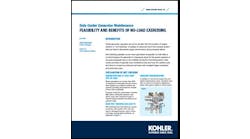Transforming Data Center Management with Centralized DCIM Insights
Multi-site HyperScalers and colocation operators face a crucial challenge: centralizing intelligence while maintaining effective governance across diverse data center environments.
Centralized data management is vital for robust data center governance. Data Center Infrastructure Management (DCIM) systems play an essential role by consolidating data from various sources, providing a comprehensive view of data center operations. This unification enhances compliance, mitigates risks, boosts operational efficiency, and streamlines capacity planning. Implementing a DCIM solution ensures consistent standards and processes across multiple data centers, allowing organizations to operate more effectively.
Understanding Governance in Data Center Management
In the realm of data centers, governance encompasses the framework of principles, policies, processes, and decision-making structures that promote effective oversight and management of operations. Governance is the cornerstone that connects compliance, operational efficiency, resource optimization, capacity planning, and sustainable practices.
Effective governance relies on having comprehensive, accurate, and timely data illuminating every aspect of the data center ecosystem. Centralized DCIM insights empower stakeholders to proactively identify and mitigate risks, eliminate inefficiencies, synchronize processes across distributed portfolios, and foster continuous improvement.
The emergence of Data Center Infrastructure Management (DCIM) solutions has been transformative. By consolidating monitoring and management capabilities into integrated platforms, DCIM provides unparalleled visibility into the intricate, interdependent systems that drive modern data centers. To fully leverage these solutions, organizations must access open, vendor-neutral data streams that transcend proprietary silos.
Enhancing Compliance and Risk Mitigation
Adhering to industry standards, regulatory mandates, and internal policies is essential for any data center operator. Leading DCIM solutions consolidate real-time data on power usage effectiveness (PUE), water usage effectiveness (WUE), carbon footprint, renewable energy utilization, and other Key Performance Indicators (KPIs) into a single view. This transparency enables proactive risk identification and mitigation, streamlining reporting and audit processes to ensure ongoing compliance.
Driving Operational Efficiency and Resource Optimization
Maximizing the utilization of critical resources such as IT equipment capacity, data center floor space, power infrastructure, and cooling systems is a constant challenge. A comprehensive DCIM platform provides detailed visibility into resource consumption across your facility. This data-driven approach allows you to identify inefficiencies, implement load balancing, improve provisioning, and maximize the value derived from your infrastructure investments while reducing costs and environmental impact.
Capacity Planning and Sustainable Growth
Effective capacity planning is crucial to ensure your data center can sustainably scale to meet changing business demands. By integrating historical trends, real-time utilization metrics, and predictive analytics into a centralized DCIM system, organizations can make informed decisions about future capacity needs. This strategic, data-driven methodology enables proactive growth planning, avoids costly overprovisioning, and future-proofs your infrastructure.
Centralized Portfolio Governance and Benchmarking
For organizations managing multiple data centers, centralized portfolio governance is critical for maintaining consistent standards, processes, and KPIs across all sites. Advanced DCIM platforms consolidate data from disparate facilities, promoting harmonized operations, benchmarking, and best practice sharing, ultimately leading to increased efficiency and cost savings.
The OpenData Advantage
When choosing a DCIM solution to enhance your governance capabilities, few alternatives can match the power and flexibility of Modius' OpenData platform. Built on open APIs and industry standards, OpenData dismantles proprietary barriers, enabling seamless integration of data from diverse infrastructure components, IT assets, and sensor networks.
This exceptional vendor-neutrality empowers organizations to adopt best-of-breed tools and systems without being confined to restrictive data formats or siloed ecosystems. The result is a future-proof, interoperable environment providing a single source of truth for all data center insights—serving as the bedrock for robust governance practices that drive operational excellence.
In the ongoing quest for sustainable, efficient, and compliant data center operations, governance is the essential framework that unites all core objectives. By harnessing the power of OpenData's centralized, vendor-agnostic data consolidation capabilities, organizations gain the transparency and control necessary to shift governance from a reactive function to a proactive, strategic imperative.

Ray Daugherty
Ray Daugherty is Senior Services Consultant at Modius.
Modius, a San Francisco-based Veteran Owned Small Business (VOSB Certified), is a premier provider of end-to-end solutions for managing the availability, capacity, and efficiency of critical facilities, including data centers, smart buildings, telecommunications, and IoT environments. Our flagship product, OpenData, offers a comprehensive suite of tools for managing the performance of mission-critical infrastructure, from device integration to analytics and dashboards.
Schedule a personalized demo today to discover how OpenData can unlock the full potential of your infrastructure. Connect with our team at 1-888-323-0066 or email us at [email protected] to learn more.






